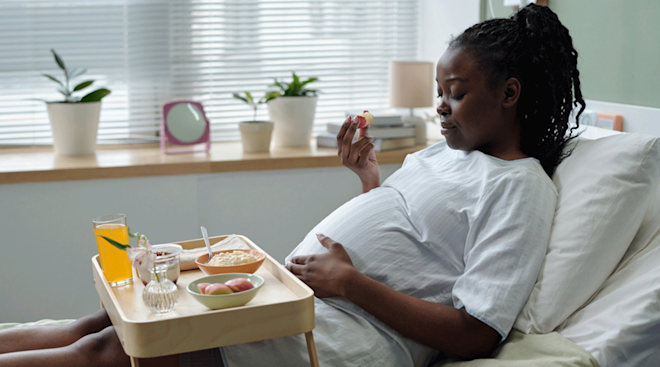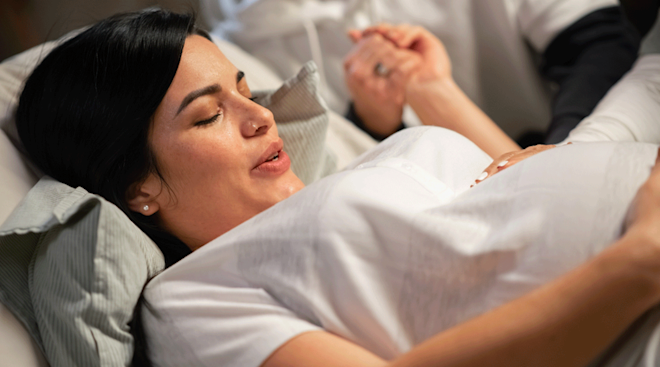What Does It Mean to Have a Breech Baby?
You’re almost full term and the finish line is approaching, when suddenly your OB or midwife informs you that baby is breech—plot twist! If baby is in a breech position, it means their feet or bottom is pointed toward your cervix rather than their head. You’ve just encountered an early example of a universal truth in parenting: Few things ever go as perfectly as you planned.
A breech birth often means a c-section delivery is in store for you, and that can feel disappointing and worrisome, especially if you’ve been hoping to deliver vaginally. Deep breath— you may still have options; your doctor will talk you through everything well before the big day comes. In the meantime, it’s helpful to get a better grasp on all things breech baby. Want to know how to tell if baby is breech, what the position means for your pregnancy, how it affects delivery and ways your doctor (and you!) can try to turn baby? Read on for the full lowdown.
In the last few weeks of pregnancy, most babies move in the womb so that their heads are facing down, positioned to come out of the vagina first during delivery. But if baby is breech, their head is not approaching the birth canal; rather, it’s their feet or bottom that’s poised to come out first.
Types of breech positions
There are three different types of breech positions, according to the American Pregnancy Association:
- Complete. Baby’s buttocks are pointing down and legs are crossed beneath it
- Frank. Baby’s bottom is positioned down and legs are pointed up toward the head
- Footling. Baby has one leg pointed toward the cervix, poised to deliver before the rest of their body. “There’s also a double footling breech, where the baby’s feet and legs are facing down toward the cervix,” says Elizabeth Deckers, MD, director of the maternal quality and safety program at Hartford HealthCare.
Baby could also be in a transverse lie position (occasionally referred to as a transverse breech position). This means that they’re horizontal across the uterus instead of vertical.
What percentage of babies are breech?
According to the American Pregnancy Association, approximately 1 out of every 25 full-term births involves a baby in a breech position. That means roughly 4 percent of babies have their bottom and/or feet pointed down toward the birth canal.
Your doctor won’t be too concerned if baby is in a breech position throughout most of your pregnancy. In fact, it’s likely that at some point in your second or early third trimester, baby will be breech. At this early stage, though, baby is smaller and has more room to move around and turn, notes Deckers.
As baby grows and your due date nears, a breech position becomes slightly more concerning. For starters, there’s some evidence linking a breech presentation—and its tendency to reduce the amount of space in the womb—with hip dysplasia, a condition where the ball and socket joint of baby’s hip doesn’t properly form.
Your doctor or midwife may raise a red flag if baby is in breech position at 36 weeks or later. At this point, they’ll probably start talking about the potential need for a c-section. “Vaginal breech delivery is no longer commonly done in the US because about 20 years ago there was a large, well-designed trial that showed there was more risk to the fetus of going through a vaginal breech delivery versus being born by a c-section,” says Deckers. The trial showed that breech babies born vaginally were more likely to have fetal fractures and a harder time getting out of the birth canal, says Amber Samuel, MD, medical director of Obstetrix Maternal-Fetal Medicine Specialists of Houston. Deckers reiterates this, noting that most babies in the US identified as breech will be born via c-section, as doctors “believe it’s safer in the short run for baby.”
Don’t beat yourself up or worry that you did something wrong in pregnancy to put baby into a breech position. The truth is there’s usually no rhyme or reason to explain baby’s breech presentation, says Samuel. That said, if you have a uterine anomaly, where your uterus is wider at the top or generally more narrow, it may play a role, she says. “If the shape is abnormal, some babies get stuck,” she says. Having too much amniotic fluid around baby might also be a potential factor.
The American College of Obstetricians and Gynecologists (ACOG) lists other factors that might contribute to baby being breech: you’ve been pregnant before, you’re expecting twins or multiples, you have placenta previa (where your placenta is covering part of your uterine opening) or baby is preterm. Suffice it to say, though, that these potential breech baby causes are out of your control.
You might be able to detect that baby is breech if you feel them kick low near your cervix or feel their head under your ribs, says Deckers. Samuel notes that some moms who’ve had babies before are really good at determining how and where they’re positioned.
Doctors gauge baby’s position by placing their hands on different parts of your belly to feel where fetal parts are, a technique known as Leopold’s maneuvers, explains Samuel. They may also perform a cervical exam to see if they can feel any presenting parts. Sometime around 36 or 37 weeks, they’ll confirm baby’s position with an ultrasound.
You may not know if or when baby is in a breech position. Earlier on in your pregnancy, when they’re smaller and have more room in the womb, they may flip all around; roughly 20 percent of babies are breech at 28 weeks, says Samuel. If you discover that your little acrobat is breech at this stage, don’t panic; there’s still more than enough time for them to flip into the preferred position (and then possibly do a few more rotations).
Are breech babies more painful to carry?
The good news: Breech presentation doesn’t typically cause discomfort or pain during pregnancy, Samuel says. Pain is more likely related to “prior scar tissue, the size of your baby and your pregnancy history,” she adds.
There is a possibility for a vaginal breech birth under the right circumstances. Deckers notes that you may be a candidate if baby is in a frank or complete breech presentation and your pelvic structure is adequate for vaginal birth—and if your hospital has guidelines in place for a planned vaginal breech delivery. Unfortunately, the risk of the umbilical cord falling through the cervix is too high with a double footling breech; there’s also a higher risk that baby will get stuck during delivery, which can cause birth asphyxia. Of course, you’ll also want to ensure that your doctor has a lot of experience with vaginal breech delivery and that your hospital will allow it.
If baby is in a breech position beyond 36 weeks and your doctor feels that a vaginal birth is too risky, they’ll likely recommend that you allow them to try turning baby—more on that soon. If that’s not successful, you’ll be scheduled for a c-section, says Samuel.
Having twins where one is breech changes the game a little too. If the baby that’s poised to come out first is breech, you’ll have to deliver via c-section, says Deckers. But if the first baby is head down and second is not, you and your OB have three options: deliver both via c-section; deliver the first baby vaginally and then attempt to turn the second one to deliver vaginally (if it’s unsuccessful, you’ll proceed with a c-section) or deliver the first vaginally and then do a breech extraction of the second baby (your OB will reach inside to grasp baby’s feet and pull them down.)
“The ability to do a safe breech extraction depends on the gestational age of the babies, how well the mother and babies are tolerating labor, the size of the babies and a provider with experience in performing this procedure,” says Deckers.
Many parents want to have a vaginal birth; what’s more, they know that a c-section is a major surgery with inherent risks. To that end, before scheduling a c-section, most doctors will suggest trying an external cephalic version (ECV), which is an attempt to turn baby from the outside.
First you’ll be given medication to relax your uterus; don’t worry, your doctor will continually monitor baby. “One hand elevates the fetal breech out of the pelvis and you push up and away from the pelvis,” says Samuel. “The other hand is on the back of baby’s head to induce them to turn over—it looks like an aggressive belly massage.”
Your doctor will push baby forward before attempting a backward roll. “You can tell pretty early into it whether it’s going to work or not—some babies are ready to flip, some aren’t,” says Samuel. “We try not to struggle too much with it.”
External cephalic versions are successful roughly 58 percent of the time, says Deckers, although there’s always the chance that baby will flip back to breech on their own. If the turning is successful and you’re at 39 weeks, you can choose to be induced. If it didn’t work, you’ll be scheduled for a c-section. ECVs should only be performed in hospitals equipped to perform emergency c-sections; risks of the procedure, which are rare, include bleeding from the placenta, rupture of membranes and going into labor, says Samuel.
It’s also worth noting that not every mom is a candidate for an EVC. If you’re having multiples or there’s a problem with placental position, an EVC is too risky, according to the ACOG.
Safe ways to try to turn a breech baby at home
If you prefer to try to make things happen on your own, there are a few things you can do to help turn a breech baby from the comfort of your home. Deckers notes, though, that research on DIY techniques hasn’t provided strong enough evidence to prove that they really work.
A little bit of gentle prenatal yoga may help. One pose to practice? Deckers says some moms try “a head down/knee-to-chest position.” You can also assume a few different sleeping positions to turn a breech baby: “Mothers can try positional things like elevating your pelvis,” she says. Finally, Deckers mentions two Eastern medicine techniques that many moms actively seek out: acupuncture and moxibustion, a therapy that involves waving burning dried plant bundles over specific parts of the body to encourage baby to turn on their own. These methods have been long used, but she points out that the efficacy of these methods haven’t been proven in trials, so “the data isn’t compelling enough to say this is something you should do.”
If baby is presenting breech and you and your doctor decide to move forward with a vaginal delivery, there are some potential complications to be aware of that could ultimately affect baby’s health and well being.
It’s possible for baby’s head or shoulders to get wedged against your pelvic bones; a prolapsed umbilical cord could also decrease blood flow and cut off baby’s oxygen supply, explains the ACOG. That said, even a planned c-section comes with its own set of risks.
Welcoming a healthy baby into the world is the ultimate goal, regardless of how they’re delivered. Interestingly, babies who’ve been in breech presentation and are delivered via c-section tend to have nicely shaped heads because there’s none of the swelling and other head-shifting changes that occur in babies delivered through the birth canal, notes Deckers.
Sometimes babies who were breech have issues with their hips, as having one or both legs extended in a partially straight position rather than crossed can prevent a baby’s hip socket from developing properly. If your child was breech, Deckers recommends following up with your pediatrician.
Having a breech baby was probably not in your original birth plan. Your stubborn little one may turn before their grand debut, or they may—quite literally—put their foot down and refuse to budge. Either way, talk to your doctor about any concerns. And remember, the good news is that baby is coming soon, either way!
Please note: The Bump and the materials and information it contains are not intended to, and do not constitute, medical or other health advice or diagnosis and should not be used as such. You should always consult with a qualified physician or health professional about your specific circumstances.
Plus, more from The Bump:
Elizabeth Deckers, MD, is the director of the maternal quality and safety program at Hartford HealthCare. She received her medical degree from the University of Connecticut School of Medicine in Farmington.
Amber Samuel, MD, is the medical director of Obstetrix Maternal-Fetal Medicine Specialists of Houston. She earned her medical degree at Baylor College of Medicine in Houston, Texas.
American Pregnancy Association, Breech Presentation
Lancet, Planned caesarean section versus planned vaginal birth for breech presentation at term: a randomised multicentre trial. Term Breech Trial Collaborative Group , October 2000
American College of Obstetricians and Gynecologists (ACOG), If Your Baby Is Breech
Learn how we ensure the accuracy of our content through our editorial and medical review process.
Navigate forward to interact with the calendar and select a date. Press the question mark key to get the keyboard shortcuts for changing dates.




















































